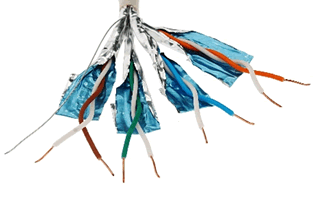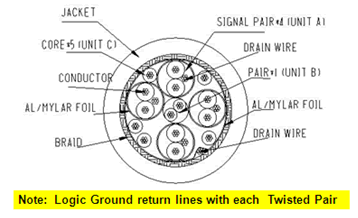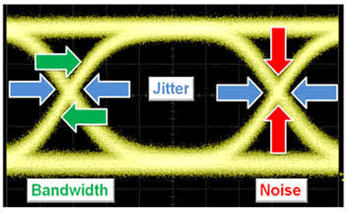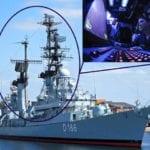Twisted Pair Cable for High-Speed Interconnections
The demand for twisted pair differential signal cable has skyrocketed to serve a new generation of high-speed military products ranging from surveillance devices to portable computers.
By Bob Stanton, Director of Technology, Omnetics Connector Corporation
 Twisted Pair Cable for High-Speed Interconnections
Twisted Pair Cable for High-Speed Interconnections
As high-speed digital circuit design evolves for use in portable and other environmentally challenging applications, the connector interface and the cable design, wiring, and style become significantly more important. Much of the military’s new equipment is moving to micro- and nano-sized packages, and many of these devices, including small satellites, soldier-worn computers, and surveillance cameras on unmanned vehicles, are exposed to extreme conditions.
The design, material selection, and manufacturing processes required to address these demands are pushing cable factories, connector providers, and customers to rethink the electronic features needed to send high-speed ones and zeros down a cable to meet up and offer good information at the other end.
Low-voltage differential signaling (LVDS) has been used for years for camera and television displays. In these applications, cables pass alternate voltage signals down the tightly twisted wires and compare them at the other end. One big benefit of this is that it reduces electromagnetic noise by having equal and opposite signals in the pair of wires. Signal speeds were initially standardized at less than one gigabit, but were later revised to 3Gb/s to serve newer high- speed video applications. Since that time, the demand for twisted pair differential signal cable has skyrocketed to serve even higher speed products ranging from surveillance devices to portable computers.
High-speed digital signal integrity is dependent on a number of critical electrical capabilities, such as impedance, noise, and skew. One must ensure that the cable matches the impedance of the circuitry to which it is connected. Impedance matching is similar to matching the load on a truck. One small box in a semi-trailer is as bad a match as hundreds of boxes stacked on the back of a pickup truck. Most often, circuits and cable are designed to work at 50Ω impedance.
 Cable noise and jitter can destroy the signal and make it impossible for the receiving circuits to understand it. Most critical in differential signal management is controlling skew. Remember, one half of the signal is placed on one of the twisted wires in the pair and the other half of the signal is loaded onto the other wire. The electrons for both sides of the signal must travel through the cable and arrive at the other end at exactly the same time. Any differences in their arrival time is called skew. When skew is too high, the receiving instrument cannot understand the data being transmitted. Low skew is critical and is often specified in a time lapse of less than 15 picoseconds delay from one signal to the other. Cable wire placement and signal groups must be isolated with shielding from group to group, such as in the IEEE
Cable noise and jitter can destroy the signal and make it impossible for the receiving circuits to understand it. Most critical in differential signal management is controlling skew. Remember, one half of the signal is placed on one of the twisted wires in the pair and the other half of the signal is loaded onto the other wire. The electrons for both sides of the signal must travel through the cable and arrive at the other end at exactly the same time. Any differences in their arrival time is called skew. When skew is too high, the receiving instrument cannot understand the data being transmitted. Low skew is critical and is often specified in a time lapse of less than 15 picoseconds delay from one signal to the other. Cable wire placement and signal groups must be isolated with shielding from group to group, such as in the IEEE  specification number 1394 pictured here.
specification number 1394 pictured here.
Typical applications for high-speed twisted pair today go beyond our home computers and gaming devices. The list is long and growing, with speeds increasing above 5Gb/s per line set. Multiple line sets can be used to achieve additional multiples of that. Common uses today include portable computers, helmet visual displays, backpack processors for soldiers’ surveillance systems, compact Ethernet systems, missile seeker heads and gyros, robotic data processors, HDMI TV, and USB 3.0, and USB 3.1.
Testing and certification of performance has also become necessary. Normal tests that watch for good impedance matching are added to an older process used in transmission line analysis called eye diagram testing. This method overlaps the two wire signals and looks for differences in skew (at the crossovers), jitter, and noise, as well as offers a window that shows if the signal matches the speed of the circuit.
 The immediate future of twisted pair cable includes more focus on size, weight, and power (SWaP) and mixed signal within one cable assembly. One example is a fast break-away micro-circular connector wired for special applications. This connector contains two nano-coax at 50Ω impedance carrying up to 18GHz analog signals and nine signal pins that can be connected to twisted pair sets for high speed differential signals running over 5Gb/s. Additional formats include power plus twisted pair within the same cable, which offers a power source and drain plus high-speed digital signal processing for cameras in robotic and remote control circuitry. These fast-break micro-circular connectors offer the user a quick replacement of their data storage device so collected information can be downloaded while the equipment is back in the field collecting more images.
The immediate future of twisted pair cable includes more focus on size, weight, and power (SWaP) and mixed signal within one cable assembly. One example is a fast break-away micro-circular connector wired for special applications. This connector contains two nano-coax at 50Ω impedance carrying up to 18GHz analog signals and nine signal pins that can be connected to twisted pair sets for high speed differential signals running over 5Gb/s. Additional formats include power plus twisted pair within the same cable, which offers a power source and drain plus high-speed digital signal processing for cameras in robotic and remote control circuitry. These fast-break micro-circular connectors offer the user a quick replacement of their data storage device so collected information can be downloaded while the equipment is back in the field collecting more images.
Interested in a specific market? Click a market below for current articles and news.
Automotive, Consumer, Industrial, Medical, Mil/Aero, Datacom/Telecom, and Transportation












